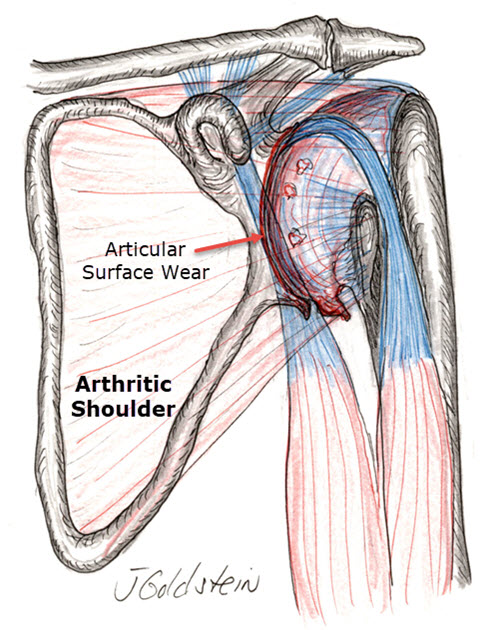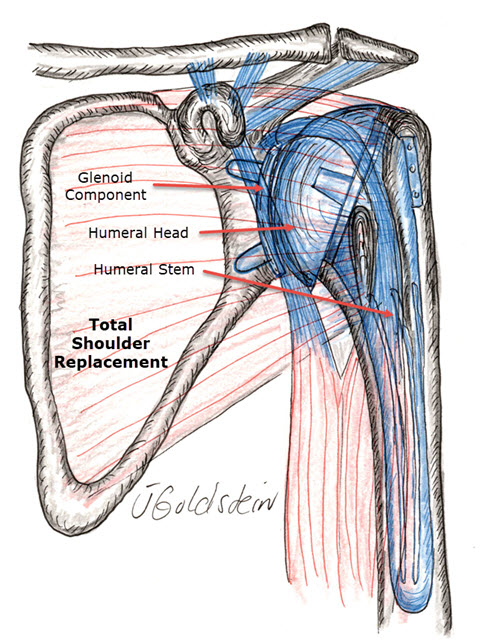Total Shoulder Replacement
Shoulder Arthritis may be very disabling. Osteoarthritis (arthritis from wear of the shoulder joint), may be caused or aggravated by prior dislocation of the shoulder, fracture, prior surgical intervention or other trauma to the shoulder. Rheumatoid arthritis may also cause similar wear and disability. This may lead to pain, limited range of motion, grinding of the shoulder, and poor functional capacity of the upper extremity.
Symptoms 
Symptoms generally include limited range of motion, crepitation or a grinding sensation within the joint on movement. Pain is often exacerbated by activity, and night-time awakening is common. The base of the neck may be “tight” with recurrent spasm, but sensation in the arm is generally normal. Patients do not complain of numbness or tingling, only pain. As in arthritis in other joints, as the surfaces wear, and bone against bone contact ensues, motion becomes increasingly limited. It is common for a patient with shoulder arthritis to present with complaints which are little different than those of a rotator cuff tear. The patients have the same limited active range of motion with pain at the extremes, and night-time awakening, but with rotator cuff tear there is also the weakness of rotation. In this situation, the plain X-Ray exam is very helpful in diagnosis. Generally, there is no need for MRI or other studies unless there is a question of a coexistent rotator cuff tear when this will substantially alter treatment.
Treatment
Treatment of the shoulder with arthritis is dependent upon the cause of the condition and the severity of arthritis. Patients may have co-existent rotator cuff tendinitis, distal clavicle arthritis, or cervical arthritis with similar symptoms. Nerve entrapment in the upper extremity may even mimic symptoms of shoulder osteoarthritis. Patients who have had recurrent dislocation or massive rotator cuff tear may develop arthritis of the shoulder as a consequence of these underlying conditions. In addition, prior surgical intervention for dislocation of the shoulder may lead to late arthritis if old non-anatomic techniques of stabilization were utilized. These may leave the shoulder capsule unbalanced and overload the shoulder creating early wear. Instability of the shoulder itself, with recurrent dislocation, also may lead to arthritis due to the damaging effect on the shoulder as it is scuffed between being located and dislocated
“Conservative” measures for the treatment of arthritis of the shoulder consists of oral anti-inflammatory drugs, gentle passive and active range of motion exercises, and strengthening of the rotator cuff musculature to maintain the normal function of the shoulder and minimize pain. Ice after aggravating activities and heat application during intervals between times may be soothing for symptomatic relief of symptoms.
Orthopedic Surgery
Shoulder Replacement may be performed on the humeral (ball) side of the shoulder, with or without the glenoid (cup side of the joint). The decision to replace one or both sides is dependent on the cartilage wear on the glenoid, and the patient’s age and activity level. If the patient is relatively young and active, with only mild glenoid wear, then hemiarthroplasty (replacing the humeral head only), is appropriate. This gives good pain relief and restores motion and function. In general, the motion achieved after Hemiarthroplasty may be expected to be more normal than after Total Shoulder Replacement, but the pain relief is less complete. After hemiarthroplasty, as the glenoid continues to wear, shoulder pain may return. This could necessitate later conversion to a Total Shoulder by adding a glenoid (cup) component. Hemiarthroplasty is also commonly used for shoulder fractures which destroy the humeral head and its blood supply but do little to damage the glenoid.
Difficulty with shoulder reconstruction may occur if the rotator cuff is torn or there is significant capsular imbalance secondary to recurrent dislocation or previous surgery for shoulder instability.
Hospitalization
Shoulder Replacement surgery generally requires one or two days of hospitalization. The surgery can be performed with General Anesthesia or Scalene Block with IV sedation. In either instance, a scalene block is utilized for pain relief in the immediate postoperative period. This is an injection of local anaesthetic at the base of the neck which numbs the shoulder and gives excellent pain relief for 6 hours or more.
Oral pain medications can often be used immediately with this technique, eliminating IV analgesics. This generally improves pain relief after surgery more effectively, since oral analgesics have a much longer duration of action than intravenous analgesics. 
Rehabilitation
Physical therapy begins the day after surgery. The motion of the shoulder is initiated passively. This means that motion of the shoulder occurs with the help of a therapist or by using a pulley with the non-operative hand to pull the operative arm overhead. The shoulder may also be moved gently by dangling the arm and swinging it forward and back and in gentle circles like a pendulum. This minimizes the load on the rotator cuff which is repaired after Shoulder Replacement. The shoulder is protected with a sling for a few weeks, and rotation may be aided with a dowel or broomstick aided by the other hand. The stick can also be used behind the back between the arms to aid extension.
- Week 1-4: Passive Range of Motion exercises and modalities for pain and inflammation. (ice and oral anti-inflammatories).
- Week 4-8: Early strengthening using isometrics followed by light active strengthening.
- Week 8-12: Active Range of motion including reaching at arms reach and overhead. Rehabilitation may need to be modified when Shoulder Replacement is combined with repair of a torn rotator cuff.
Complications
As with any surgery, there are risks. The shoulder is a complex joint to replace. It relies on soft tissue balance and prosthetic orientation to maintain stability. Dislocation may occur if therapy is improper, soft tissue balance or prosthetic orientation is not correct, or injury occurs. As with any prosthetic joint, infection is the most worrisome risk. This may necessitate prosthetic removal, clearance of the infection and reimplantation. After surgery, antibiotics should be taken before dental cleaning, oral surgery or colonoscopy to minimize the risk of late infection.
Summary
Total Shoulder Replacement is generally highly effective for pain relief in instances of severe shoulder arthritis. This may be complicated in instances of a rotator cuff tear, fracture, or prior shoulder surgery.
Compliments of Sports Medicine and Orthopaedics, East Providence, Rhode Island
